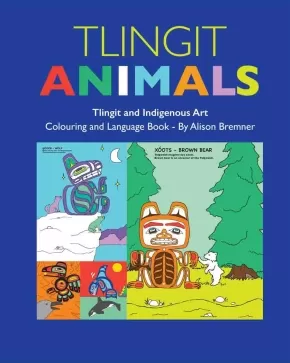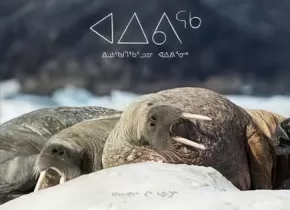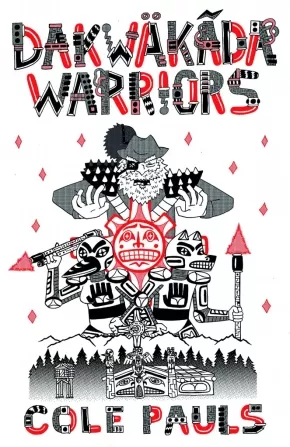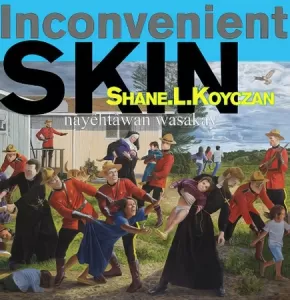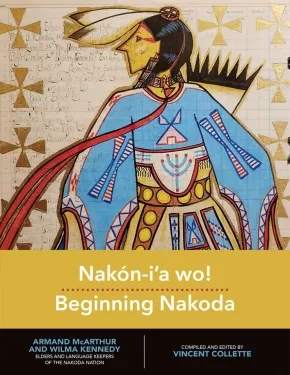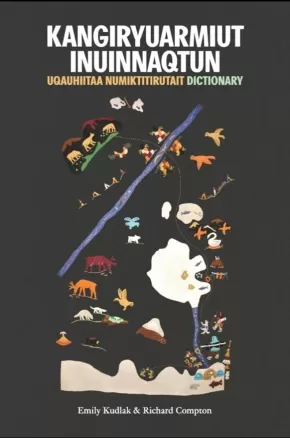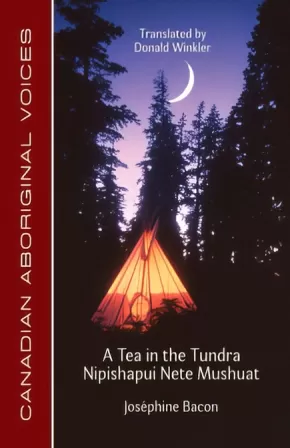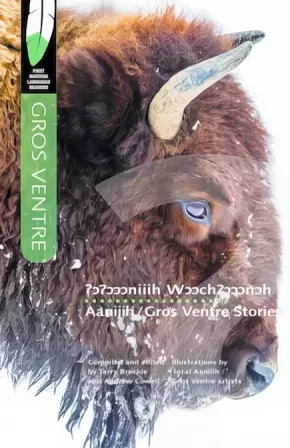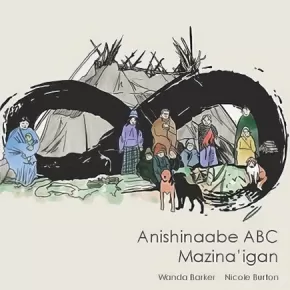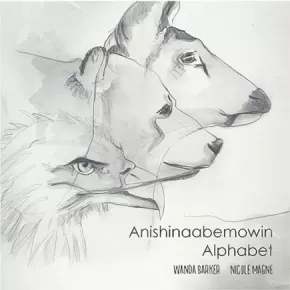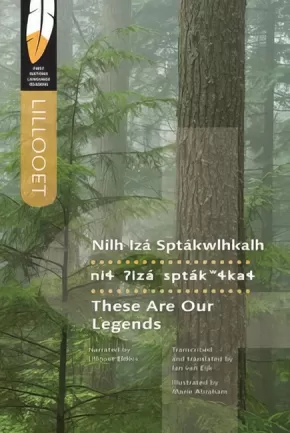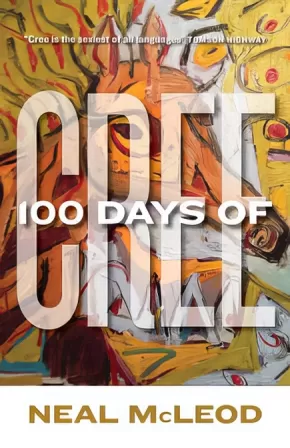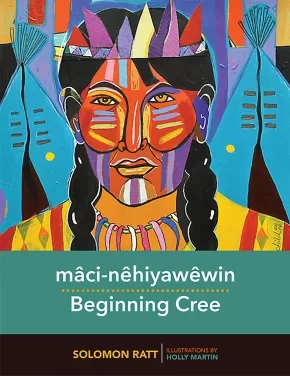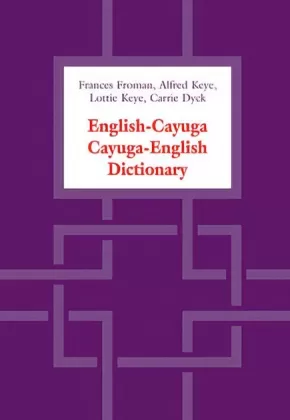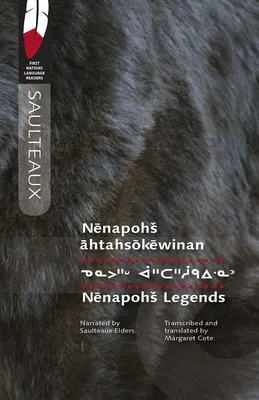
Language Learning
16
-
30
of
31 Results;
Sort By
Go To
of 3
Tlingit Animals: Tlingit and Indigenous Art Colouring and Language Book
$9.00
Artists:
Format:
Paperback
Text Content Territories:
Indigenous American; Alaska Native; Tlingit;
ISBN / Barcode: 9781554766239
Synopsis:
Synopsis:
Alaskan Alison Bremner reclaims her ancestral language in this Tlingit coloring book featuring her original art. Alongside each drawing, each animal is identified by their English and Tlingit names. The English and Tlingit sentences below explain each animal’s cultural significance. Tlingit Animals is intended to teach younger generations Tlingit culture and language, in addition to developing reading skills and creativity.
Educator Information
24 pages colouring and language book Tlingit Indigenous Art
Printed in Canada
Additional Information
24 Pages
Aiviq (Inuktitut): Life With Walruses
$27.95
Artists:
Format:
Paperback
ISBN / Barcode: 9781772272024
Synopsis:
Synopsis:
Massive, elusive, and always deserving of respect, the walrus is one of the Arctic’s most recognizable animals. For thousands of years, Arctic residents have shared the coastlines and waters of the Arctic with these huge beasts. Often misunderstood by people who have not had first-hand encounters with them, walruses are known to those who share their habitat as somewhat unpredictable creatures, always deserving of caution when encountered. From close encounters with angry walruses, bent on destroying boats and chasing off humans to witnessing the attentive care of a walrus mother with its calf, this book gives readers from outside the Arctic a first-hand look at what life alongside walruses is really like.
Aiviq: Life with Walruses features stunning wildlife photography by acclaimed photographer Paul Souders accompanied by first-hand accounts from people living alongside this enormous sea mammal.
Educator Information
This book is entirely in Inuktitut.
Additional Information
|
Dakwäkãda Warriors
$20.00
Artists:
Format:
Paperback
Text Content Territories:
Indigenous Canadian; First Nations; Dene; Tahltan (Nahanni);
ISBN / Barcode: 9781772620412
Synopsis:
Synopsis:
Indigenous protectors use language revitalization to save the Earth from evil pioneers and cyborg sasquatches.
Ts’ür’i and Aghay are the Dakwäkãda Warriors protecting Nän from their nemesis Cyber Nà’į and Space Kwäday Dän. Flying in their spaceship, can they prevent the Sha being stolen from Cyber Nà’į and Space Kwäday Dän?!
As a young person growing up in Haines Junction YT, artist Cole Pauls performed in a traditional song and dance group called the Dakwäkãda Dancers. During that time, Pauls encountered the ancestral language of Southern Tutchone. Driven by a desire to help revitalize the language, he created Dakwäkãda Warriors, a bilingual comic about two earth protectors saving the world from evil pioneers and cyborg sasquatches.
Pauls’ Elders supported him throughout the creation process by offering consultation and translation. The resulting work is a whimsical young adult graphic novel that offers an accessible allegory of colonialism. Dakwäkãda Warriors also includes a behind-the-scenes view into the making of the comic and a full-colour insert featuring character illustrations by guest Indigenous Canadian artists.
Awards
- 2020 Indigenous Voices Awards Winner for Works in an Indigenous Language
Reviews
From the publisher, an interview with Cole Pauls:
1. Why did you decide to create this comic?
I wanted to create a sense of identity and strength for the youth from my hometown and the Yukon. To be portrayed in a heroic but also realistic way, where culture is power and the community is stronger because of that. I made Dakwäkãda Warriors to keep Southern Tutchone language and culture alive.
2. What do you hope your work will bring to the Canadian comics canon?
A proper portrayal of Yukon Indigenous culture, we don't live in igloos, ya know!! I want to show the world what Southern Tutchone culture really is and how strong Indigenous culture can be when properly portrayed by someone who lives and practices it.
Educator Information
Recommended Ages: 8 to 16
Language revitalization in an allegory of colonialization.
Artist Cole Pauls wanted to reclaim the Southern Tutchone language he had learned as a youth while performing in a traditional song and dance group. So, he created a comic about two Earth Protectors saving the Earth from evil pioneers and cyborg sasquatches. But he also went to his elders and asked them to translate his comic into the two dialects of Southern Tutchone. The resulting work is an allegory of colonialization done in an accessible format, a whimsical young adult graphic novel which helps to revitalize language. Pauls includes a "making of" postscript to give context to the project, and invites guest Indigenous Canadian artists to provide "pin-ups" of his characters.
Additional Information
112 pages | 6.50" x 10.00" | 112 illustrations
Inconvenient Skin / nayêhtâwan wasakay
$29.95
Artists:
Format:
Hardcover
Text Content Territories:
Indigenous Canadian;
ISBN / Barcode: 9781926886510
Synopsis:
Synopsis:
Inconvenient Skin challenges how reconciliation has become a contested buzzword filled with promises and good intentions but rarely any meaningful follow-through. While Canada's history is filled with darkness, these poems aim to unpack that history to clean the wounds so the nation can finally heal. Powerful and thought-provoking, this collection will draw you in and make you reconsider Canada's colonial legacy. The cover features the art of Kent Monkman, and the interior features work by Joseph Sanchez, a member of the Indian Group of Seven.
Written in English and Cree.
Educator Information
This collection of poems features Shane Koyczan's well-known poem, "Inconvenient Skin," delivered in a dual-language format of English and Cree and paired with illustrations, artwork, and photography.
Recommended in the Canadian Indigenous Books for Schools 2019-2020 resource list as being useful for grades 11 and 12 for these subjects: Art Education, English Language Arts.
This poem talks about sexual assault, genocide, and violence. Some of the artwork shows violence and nudity. This could be triggering for some readers.
Additional Information
80 pages | 8.50" x 8.50" | Colour Illustrations
Nakón-i'a wo! Beginning Nakoda
$34.95
Editors:
Format:
Coil Bound
Text Content Territories:
Indigenous Canadian; First Nations; Assiniboine (Nakoda Oyadebi);
ISBN / Barcode: 9780889776623
Synopsis:
Synopsis:
Nakón-i'a wo! Beginning Nakoda is a language resource designed to help revitalize and document Nakoda, now spoken in Manitoba and Saskatchewan.
Written for beginning learners of Nakoda (also known as Assiniboine), this workbook, arranged thematically, provides a Nakoda/English lexicon, a vocabulary, a table of kinship terms, a glossary of linguistic terminology, and exercises to do after each lesson.
This book was made possible with the assistance of Elders and Language Keepers of the Nakoda Nation: Armand McArthur and Wilma Kennedy, Main Consultants; with additional contributions by Pete Bigstone, Leona Kroscamp, Freda O'Watch, and Ken Armstrong.
Educator & Series Information
Recommended for Grades 7+
Part of the Indigenous Languages for Beginners series.
Additional Information
304 pages | 8.50" x 11.00" | Black and white illustrations throughout
Kangiryuarmiut Inuinnaqtun: Uqauhiitaa Numiktitirutait Dictionary
$59.95
Format:
Paperback
Text Content Territories:
Indigenous Canadian; Inuit; Inuinnait (Copper); Kangiryuarmiut;
ISBN / Barcode: 9781897568552
Synopsis:
Synopsis:
The product of intensive, highly detailed work, this dictionary is more than a language document. It is a unique window into the Inuinnait culture and way of life.
Kangiryuarmiut Inuinnaqtun Uqauhiitaa Numiktitirutait - Kangiryuarmiut Inuinnaqtun Dictionary details the Kangiryuarmiut dialect of Inuinnaqtun, as spoken in the community of Ulukhaktok in the Inuvialuit Region of Canada's Northwest Territories. Very similar dialects of Inuinnaqtun are spoken in Qurluqtuq (Kugluktuk) and Iqaluktuuttiaq (Cambridge Bay) in Nunavut.
This is the most comprehensive dictionary of any Western Canadian dialect of the Inuit language. It contains over 5,000 Inuinnaqtun entries and subentries with their translations, over 3,000 example sentences, and a large inventory of suffixes.
The introduction includes a brief overview of Inuinnaqtun, its sound system, orthography, and major word classes. Main entries include both related subentries and examples. Suffix entries include information about lexical categories, inflection, the different forms a suffix may take, and examples of how each suffix is used.
Additional Information
582 pages | 6.50" x 9.50" | English, Inuinnaqtun
A Tea in the Tundra / Nipishapui Nete Mushuat
$16.95
Format:
Paperback
Text Content Territories:
Indigenous Canadian; First Nations; Innu (Montagnais-Naskapi);
Grade Levels: 12; University/College;
ISBN / Barcode: 9781772310351
Synopsis:
Synopsis:
In this bilingual English-Innu poetry collection, Joséphine Bacon challenges our traditional notions of culture and perception, landscape and wilderness, the limits of experience, and the nature of human being. With a surreal blend of emotions and memories, A Tea in the Tundra / Nipishapui Nete Mushuat portrays a complex and ever-shifting landscape of possibilities. The author passionately reveals a finely wrought sensibility, which elevates the subtle scenery of life's everyday events.
Educator & Series Information
This book is part of the Canadian Aboriginal Voices series.
Additional Information
96 pages | 5.50" x 8.50" | Translated by Donald Winkler
Aaniiih/Gros Ventre Stories
$24.95
Editors:
Format:
Paperback
Text Content Territories:
Indigenous American; Native American; Gros Ventres (Aaniiih);
ISBN / Barcode: 9780889774803
Synopsis:
Synopsis:
The first-ever collection of Anniiih/Gros Ventre narratives to be published in the Aaniiih/Gros Ventre language, this book contains traditional trickster tales and war stories. Some of these stories were collected by Alfred Kroeber in 1901, while others are contemporary, oral stories, told in the past few years.
As with the previous titles in the First Nations Language Readers series, Aaniiih/Gros Ventre Stories comes with a complete glossary and provides some grammar usage. Delightfully illustrated, each story is accompanied by an introduction to guide the reader through the material.
The Aaniiih/Gros Ventre people lived in the Saskatchewan area in the 1700s, before being driven south during the 1800s to the Milk River area in Montana, along the USA/Canada border.
Educator & Series Information
This book is published in the Aaniiih/Gros Ventre language. An English glossary is provided at the back of the book.
The Canadian Indigenous Books for Schools list recommends this resource for Grades 10-12 for these subjects: English Language Arts, Indigenous Language Studies, Language Studies.
Aaniiih/Gros Ventre Stories is part of the First Nations Language Readers series. With a mix of traditional and new stories, each First Nations Language Reader introduces an Indigenous language and demonstrates how each language is used today. The University of Regina Press’s long-term goal is to publish all 60+ Indigenous languages of Canada.
Additional Information
120 pages | 5.50" x 8.50" | Compiled and Edited by Terry Brockie and Andrew Cowell
Anishinaabe ABC Mazina’igan
$10.00
Artists:
Format:
Paperback
Text Content Territories:
Indigenous Canadian; First Nations; Anishinaabeg; Ojibway;
ISBN / Barcode: 9781927849422
Synopsis:
Synopsis:
It's never too early to start teaching children their First Nations language, and Anishinaabe ABC Mazina'igan is a great tool to assist with learning.
This book is the second in a series by Language Facilitator, Wanda Barker. It is a great tool to assist with learning the Ojibwe language. Anishinaabe ABC Mazina’igan is filled with beautiful illustrations, Anishinaabemowin/Ojibwe sentences and their English translations. The images can serve as a starting point for discussion of the cultural relevancy of the sentences associated with each letter.
This book can be used by students, parents and teachers, young and old. It is written in the double vowel writing system and is intended to show the sequence of the Ojibwe alphabet. The images can serve as a starting point for discussion of the cultural relevancy of the sentences associated with each letter.
Educator Information
This book is written in the Ojibwe language with a glossary at the back in Ojibwe and English. It is useful for anyone wanting to learn the Ojibwe language.
Anishinaabemowin Alphabet
$10.00
Artists:
Format:
Paperback
Text Content Territories:
Indigenous Canadian; First Nations; Anishinaabeg; Ojibway;
Reading Level: N/A
ISBN / Barcode: 9781927849354
Synopsis:
Synopsis:
It’s never too early to start teaching children their First Nations language, and Anishinaabemowin Alphabet is the perfect place to begin. This book is filled with beautifully shaded illustrations, Anishinaabemowin/Ojibwe words and their English translations, and it can be used by students, parents and teachers young and old. It is written in the double vowel writing system and is intended to show the sequence of the Ojibwe alphabet. The images can serve as a starting point for discussion of the cultural relevancy of the word associated with each letter.
Educator Information
This book is written in the Ojibwe language. An English translation for each word is provided at the back of the book.
The publisher recommends this book for children or anyone learning the Ojibwe language.
These Are Our Legends
$24.95
Format:
Paperback
Text Content Territories:
Indigenous Canadian; First Nations; Salish; Interior Salish; St'at'imc (Lillooet, Lil'Wat);
Grade Levels: 12; University/College;
ISBN / Barcode: 9780889773967
Synopsis:
Synopsis:
Like all First Nations languages, Lillooet (Lil'wat) is a repository for an abundantly rich oral literature. In These Are Our Legends, the fifth volume of the First Nations Language Readers series, the reader will discover seven traditional Lillooet sptakwlh (variously translated into English as "legends," "myths," or "bed-time stories.")
These texts are presented in a technical transcription that can be used by linguists, and also in a practical orthography that can be used by Lillooet speakers themselves. An English translation is also given. Basic information on the Lillooet language, its grammar, and a glossary are included in the volume.
With thanks to the Mount Currie Cultural Centre and the Tszil Publishing House.
Series Information
These Are Our Legends is part of the First Nations Language Readers series. With a mix of traditional and new stories, each First Nations Language Reader introduces an Indigenous language and demonstrates how each language is used today. The University of Regina Press’s long-term goal is to publish all 60+ Indigenous languages of Canada.
Additional Information
120 pages | 5.50" x 8.50" | Narrated by Lillooet Elders | Transcribed and Translated by Jan van Eijk
Authenticity Note: This book has been labelled as containing Authentic Indigenous Text because of the narration from Lillooet Elders. It is up to readers to determine if this text will work as an authentic resource for their purposes.
100 Days of Cree
$24.95
Format:
Paperback
Text Content Territories:
Indigenous Canadian; First Nations; Cree (Nehiyawak);
ISBN / Barcode: 9780889774292
Synopsis:
Synopsis:
As an Elder once said, "Learn one Cree word a day for 100 days, and emerge a different person."
In 100 Days of Cree, Neal McLeod offers us a portal into another way of understanding the universe--and our place within it--while demonstrating why this funny, vibrant, and sometimes salacious language is "the sexiest of them all" (according to Tomson Highway).
Based on a series of Facebook posts, the 100 short chapters or "days" in the book present a chain of related words, some dealing with the traditional--the buffalo hunt, the seasons--and others cheekily capturing the detritus of modern life--from Internet slang to Johnny Cash songs to Viagra.
The result is both an introduction to the most widely spoken Indigenous language in Canada and the opportunity to see the world, and ourselves, in another way.
Reviews
"The nonfiction book is divided into 100 themes and offers Cree words and English explanations for everything from traditional subjects such as powwows and medicine to modern subjects such as Facebook and Star Wars. It also includes a guide to pronunciation written by Arok Wolvengrey, a linguist and the author of a Cree-English dictionary. 'When we think about indigenous languages, there’s a part of us that thinks they’re dying languages, ' URP publisher Bruce Walsh said. 'And then this manuscript comes in that demonstrates a living, vital language.' McLeod said that he and Wolvengrey worked to keep a balance between traditional usage and modern adaptations. 'To revitalize our languages, we have to do two things: we have to document the classical terminology, because within that terminology are all of our metaphors and idioms; but we also have to think of how to put old words together, to coin words, to describe the contemporary world.'" — Laura Godfrey, Publishers Weekly
Additional Information
325 pages | 5.50" x 7.00"
mâci-nêhiyawêwin: Beginning Cree
$34.95
Artists:
Format:
Coil Bound
Text Content Territories:
Indigenous Canadian; First Nations; Cree (Nehiyawak);
ISBN / Barcode: 9780889774353
Synopsis:
Synopsis:
Designed as an introduction for Cree language learners, Beginning Cree acts as a self-study aid--a much-needed resource in today's world where most students cannot speak Cree fluently. Basic grammar units and everyday vocabulary items guide the student through the building blocks of the language, and expansion drills and exercises reinforce lessons and prepare the student for further study. With over 100 delightful illustrations, Beginning Cree grounds the language in traditional and contemporary contexts.
Educator & Series Information
This book is recommended for ages 12+.
Table of Contents
Chapter One: Introduction
Chapter Two: Nouns
Chapter Three: Prepositions and Pronouns
Chapter Four: Animate Intransitive Verbs
Chapter Five: Inanimate Intransitive Verbs
Chapter Six: Possessives: Kinship Terms
Chapter Seven: Transitive Inanimate Verbs
Chapter Eight: Transitive Animate Verbs
Verb Charts
Conjugation Patterns
Vocabulary List
Bibliography
Notes
The Canadian Indigenous Books for School list recommends this resource for Grades 1-12 for these subject areas: Indigenous Language Studies, Language Studies.
Part of the Indigenous Languages for Beginners series.
The book is specifically geared towards learners of the Plains Cree "Y" dialect, also known as the "Y" dialect.
Additional Information
165 pages | 8.50" x 11.00" | black and white illustrations | spiral bound
English-Cayuga/Cayuga-English Dictionary
$81.00
Format:
Paperback
Text Content Territories:
Indigenous Canadian; First Nations; Haudenosaunee (Iroquois); Cayuga;
Reading Level: N/A
ISBN / Barcode: 9781442627093
Synopsis:
Synopsis:
The first comprehensive lexicographic work on Cayuga, an Iroquoian language spoken in southern Ontario at Six Nations of the Grand River, this dictionary, combines the work of Dyck, a professor of linguistics, and Froman, Keye, and Keye, all Cayuga language teachers at Six Nations. It contains over 3000 entries, including 1000 verb forms and many nouns never before printed; extensive cross-referencing, thematic appendices that highlight cultural references and provide 1600 further entries, and a short grammatical sketch complete this accomplished work.
Entries in the main dictionary are organized by bases, which will make the dictionary especially helpful to those learning Cayuga as a second language. The dictionary's accuracy and extensiveness will make it an indispensable reference not only to the Cayuga speaker and student, but also to other Iroquoian speakers, linguists, anthropologists, and historians of Indigenous Peoples.
Produced under the auspices of the Sweetgrass First Nations Language Council Inc.
Reviews
"The first extensive dictionary of Cayuga, this benchmark work documents the language in 3,000 entries and in word lists organized thematically in appendixes ... A valuable tool for linguists of Iroquoian languages and anthropologists, as well as those who study the Cayuga language. Summing up: Highly recommended."— R. Hanson, Choice
"A major milestone in Iroquoian studies and an extremely important tool in the preservation of the Cayuga language."— Blair A. Rudes, Department of English, University of North Carolina at Charlotte
Additional Information
786 pages | 6.88" x 9.73" | Paperback
Nenapohs Legends
$19.95
Format:
Paperback
Text Content Territories:
Indigenous Canadian; First Nations; Anishinaabeg; Ojibway; Saulteaux;
Grade Levels: University/College;
ISBN / Barcode: 9780889772199
Synopsis:
Synopsis:
These seven tales are the traditional teaching stories of Nenapohs, the Saulteaux culture hero and trickster. Oral in origin, they have been passed on through generations by the traditional teachers, the Elders.
For the first time, they are published and made available in Nahkawewin or Saulteaux, the westernmost dialect of the Ojibwe language. Each story is illustrated and is presented in both Standard Roman Orthography and syllabics, with English translation. The book also includes a pronunciation guide and a Saulteaux-to-English glossary.
Educator & Series Information
Nenapohs Legends is part of the First Nations Language Readers series. With a mix of traditional and new stories, each First Nations Language Reader introduces an Indigenous language and demonstrates how each language is used today. The University of Regina Press’s long-term goal is to publish all 60+ Indigenous languages of Canada.
Additional Information
112 pages | 5.50" x 8.50" | Narrated by Saulteaux Elders, Transcribed and Translated by Margaret Cote
Sort By
Go To
of 3

